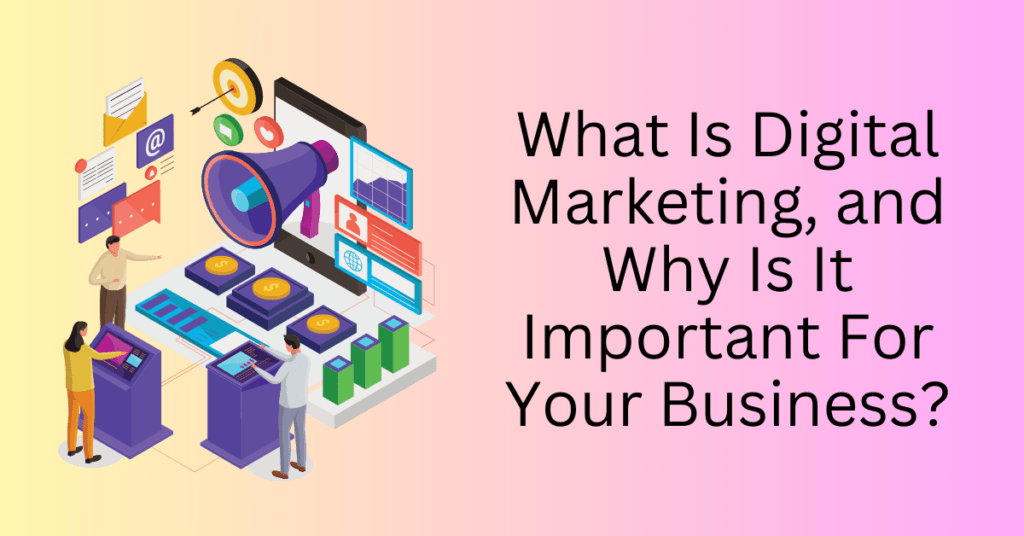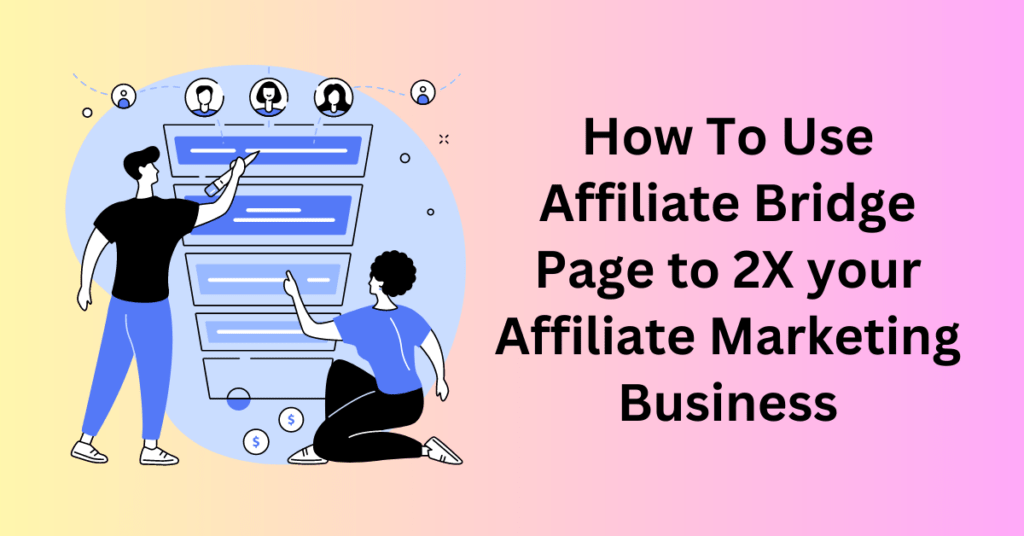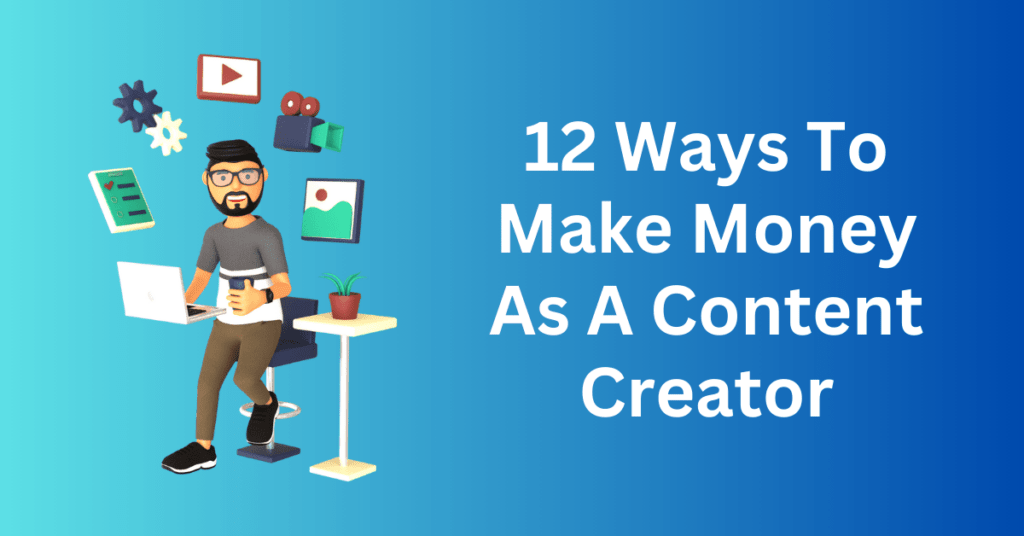You need to engage with the right audience on a large scale to build and grow your business. Digital marketing leverages the vast reach and capabilities of the internet to connect with potential customers in a more personalized and interactive manner compared to traditional marketing methods.
Today, businesses utilize various digital marketing strategies to effectively connect with their target audiences, increase brand awareness, drive website traffic, generate leads, and ultimately achieve their marketing objectives.
Today, we will explore everything about digital marketing and how you can implement it for your business.
The Basics of Digital Marketing
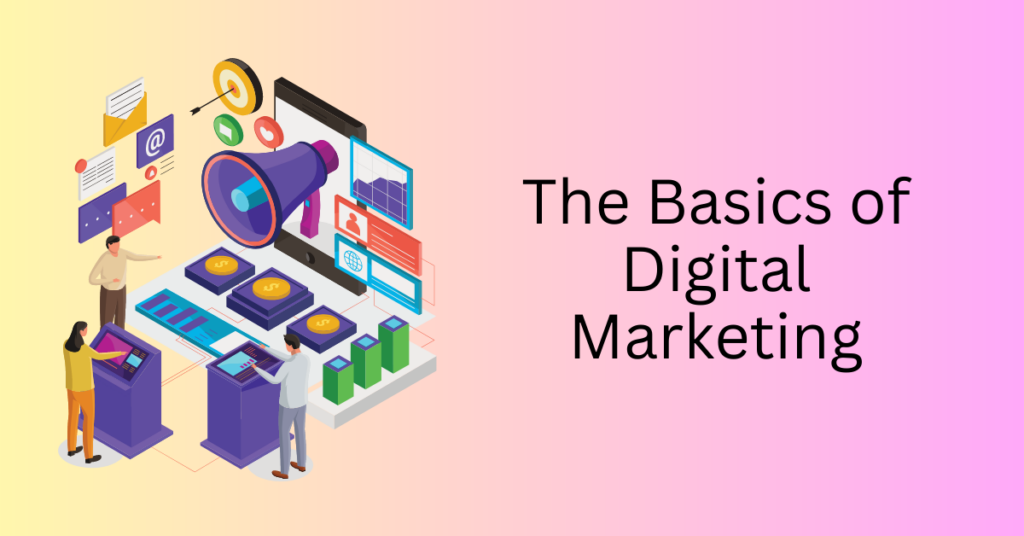
Digital marketing is a dynamic and essential practice that revolves around utilizing digital channels and technologies to promote products, services, or brands.
In this interconnected age, you can harness the power of the internet to engage with your dream customers in innovative and personalized ways. At its core, digital marketing encompasses a diverse range of strategies and tools that cater to the evolving preferences of modern consumers.
It involves optimizing websites to appear prominently in search engine results through Search Engine Optimization (SEO) and utilizing Pay-Per-Click (PPC) advertising to reach potential customers on platforms like Google and social media.
Not only that, but you need to also craft compelling content to inform and captivate audiences and leverage the influential reach of social media platforms. With the advent of influencer collaborations, email marketing, and data-driven analytics, digital marketing empowers brands to not only reach wider audiences but also interact with them in a more meaningful and measurable manner.
Digital Marketing Vs Traditional Marketing
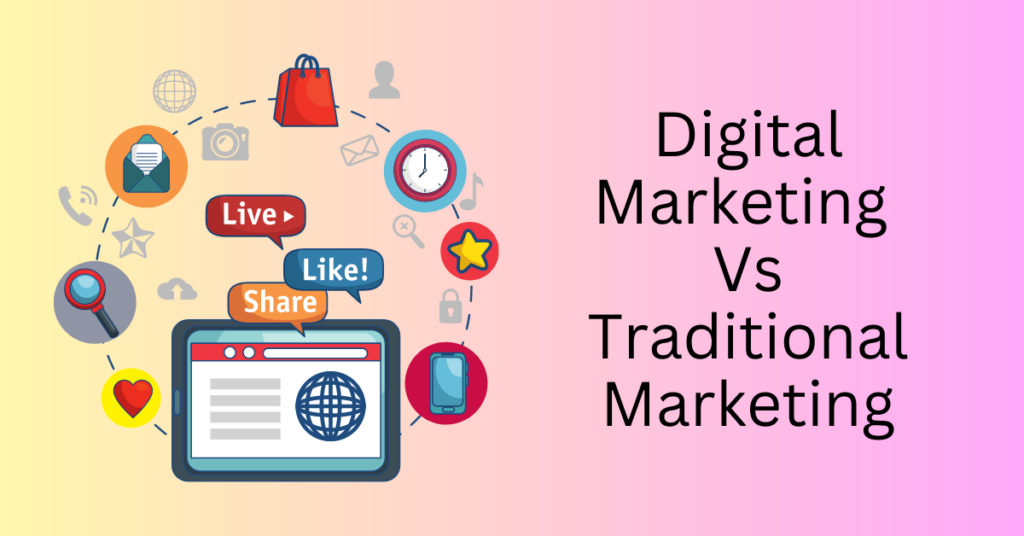
In contrast to traditional marketing, which often relies on one-way communication, digital marketing thrives on interactivity and engagement. It enables businesses to establish direct connections with their customers, fostering a sense of community and loyalty.
The highly targeted nature of digital marketing ensures that messages reach individuals most likely to be interested in the products or services offered. By collecting and analyzing data, you can gain insights into consumer behaviour, preferences, and trends, allowing for continuous refinement of strategies.
Moreover, the cost-effectiveness of digital marketing makes it an attractive option for businesses. Businesses of all sizes can implement digital marketing to reach their customers better.
Types of Digital Marketing
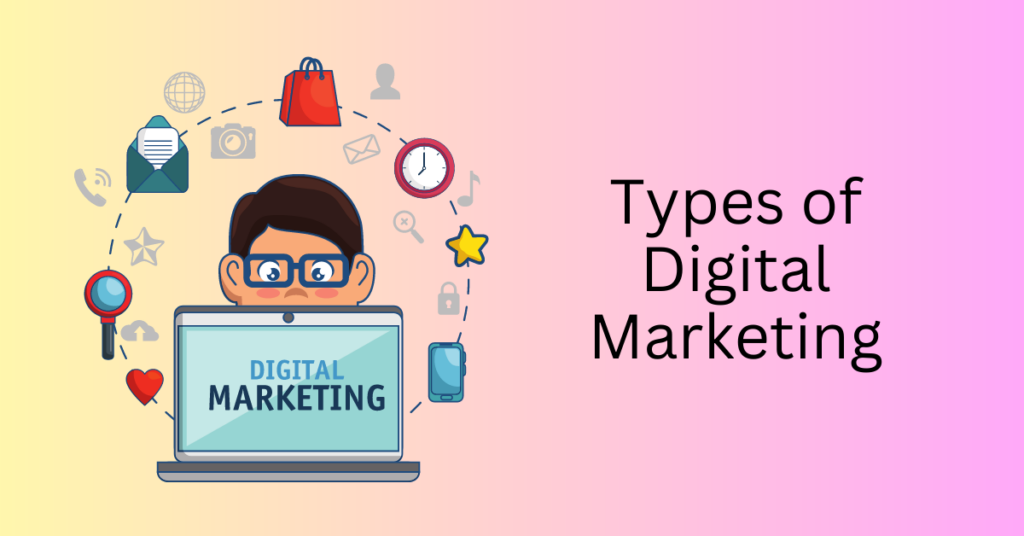
When implementing digital marketing for your business, there are different types of common digital marketing strategies that you can implement.
While you can implement all for your business, you should always start with a few methods. After that, then only expand to other methods.
1. Social Media Marketing – Digital Marketing
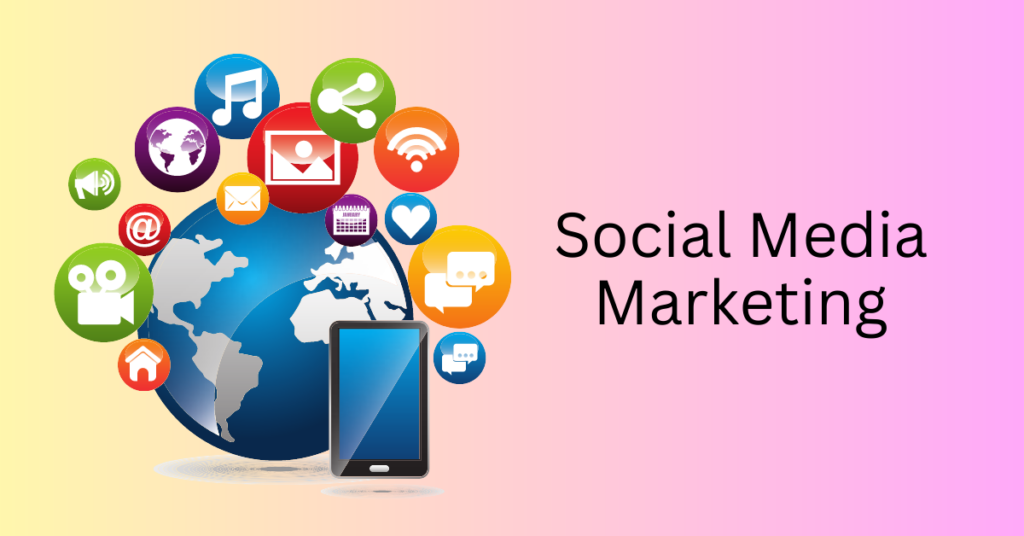
Social media is a powerful place where your target audiences hang out online. Depending on your audience group, they might be active on different social media platforms. By knowing where they are, you can tap into the group and communicate with them.
With social media marketing, you are going to create and publish engaging content. Not only that, you will need to engage in discussion to create brand awareness, drive traffic and generate leads.
With social media, you can determine whether you want to work on Facebook, Instagram, Twitter, Pinterest, LinkedIn or others.
Social media is like a party that you attend. People on social media want to communicate with each other. When you are starting, you are going to build relationships and introduce yourself to them. And then, slowly bring them to your party, aka your profile, chat or group.
The goal of your social media content is not to sell. Instead, to drive traffic to your landing page or sales funnel. People usually won’t buy when they first interact with your business. This is why you would need to build your reputation and relationships with them. And then, direct them to your sales page.
That’s where the sales happen. You will then need to write a compelling sales copy to promote your products or services. Then, close them on your sales page.
2. Search Engine Optimization (SEO) – Digital Marketing
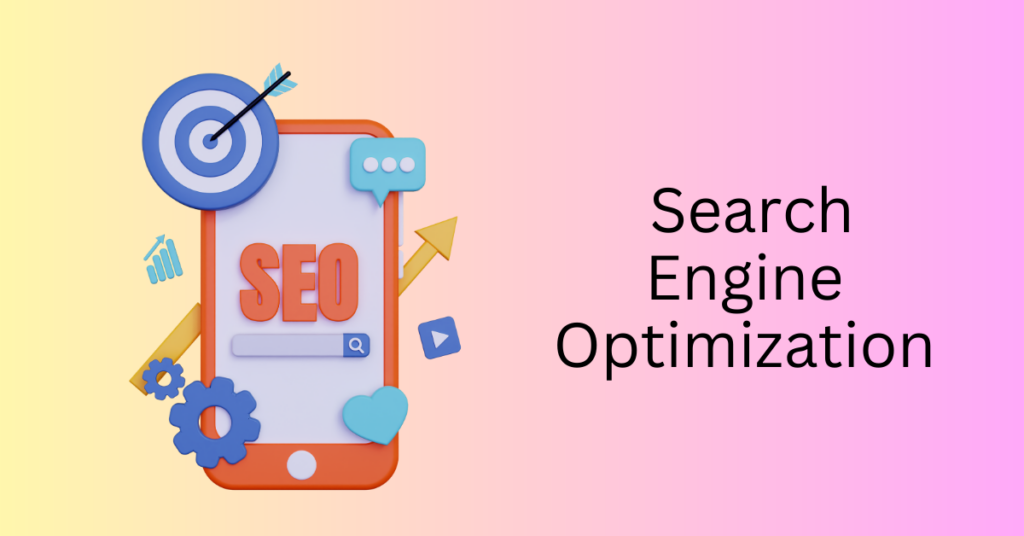
SEO is the strategy to optimize your content to get ranked on the search engine result page. When you are ranked, you will be getting organic traffic from the search engine results.
If you are ranked for the highly searched keywords, you will be getting a good amount of free traffic to your website daily.
An SEO marketing campaign will start with keyword research. This is where you will look for the keyword that you want to target on your website. Then you will optimize your website around the keyword to get ranked. Keyword research is important so that you can focus on high-quality keywords. These keywords are highly searchable and at the same time low competition.
You will have a slim chance to win the competition if it’s a highly competitive keyword. This is because the other big names already dominate the keywords. It is very hard for you to win the fight over them.
For example, if you are working on the diet niche, then you can target keywords like “keto diet”, and “how to lose weight”. But be aware that you should always know the data. Also, target the long tail keywords where it is less competitive and has a good search volume.
The SEO strategy involved on-page and off-page SEO. For on-page SEO, you will need to optimise your website title, meta tags, and content to comply with the SEO algorithms. And for off-page SEO, it will be more about how is your website’s reputation like your website backlinks and ratings.
Both are important to get your website ranked top in the search results.
3. Paid Ads – Digital Marketing
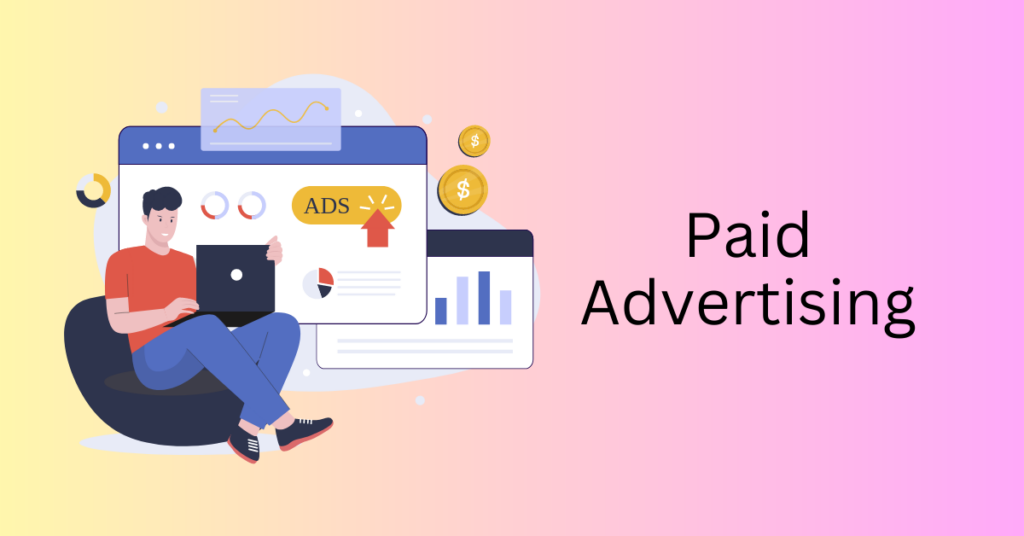
Paid ads are good for you to get your content to the right audience instantly. With paid ads, you can create your ad campaign and set for the ad to be shown to a specific group of audiences.
Then, the ad platform will work based on their database to show your ads to the right audiences. These are the people that are most relevant based on the user’s demographic and interests.
You can buy ads on search engines like Google or on social media like Facebook and Instagram. These platforms are designed with the data to help you create high-converting ads and show them to your target audiences.
Not only that but there are also pixels that you can insert into your website. This will enable you to retarget your website visitors and follow them after they visit your website.
A very important thing to be aware of is that paid ads can be very profitable at times. And at the same time make you lose a lot of money if not do it right. So, before launching your paid ads, make sure your ad copy and your landing page are working well.
Besides, you need to test different variants of your ads to find the winning copy before your ad budget runs out. The internet is everchanging, what works today might not be working tomorrow.
That’s why, it is very important that you always split-test your ads to get high conversion ads.
4. Influencer Marketing – Digital Marketing
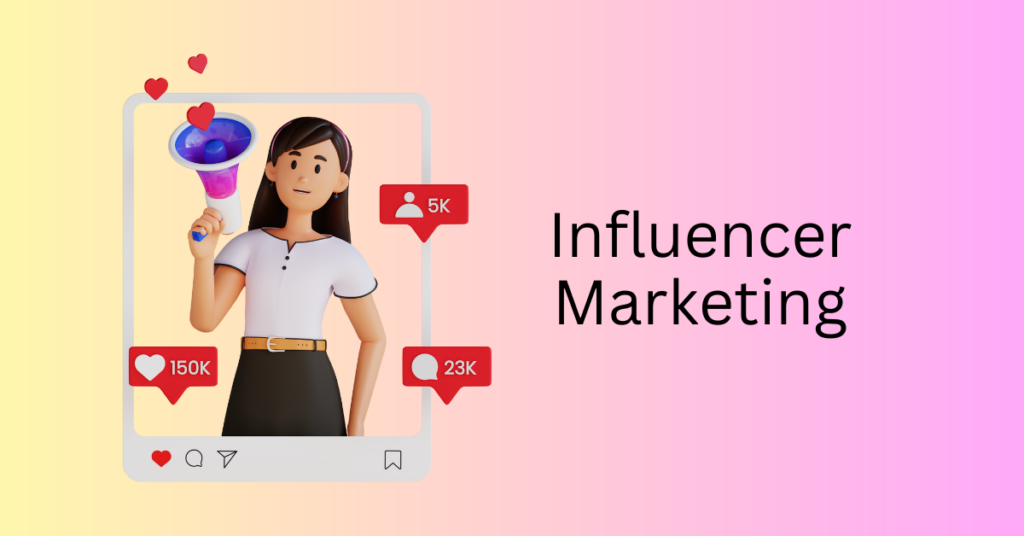
An influencer is a digital content creator who has a huge amount of followers or audiences. They worked hard to gain a large group of audience and are seen as authority figures.
Their followers will listen to their comments and reviews about a product or service. And therefore, it can be very useful if you work with the right influencer to promote your products.
Normally an influencer will be focusing on a certain topic or niche. So when you work with the right influencer, you are getting in touch with your potential customer group.
And when you collaborate with an influencer, you are paying them for:
Product Reviews – You can send them samples for them to review your product. Or, they can have a demonstration video on how it works.
Sponsored posts – You can pay them to publish a post on your offerings. It can be a time-based post or a permanent post depending on your collaboration model.
Competitions and giveaways – You can sponsor to host a competition or giveaway to their followers. This is to get exposure to your brands in front of their followers. And at the same time, they can benefit from the sponsorship to host the giveaways. Giveaways are a good way for influencers to engage with their customers as well.
5. Affiliate Marketing – Digital Marketing.
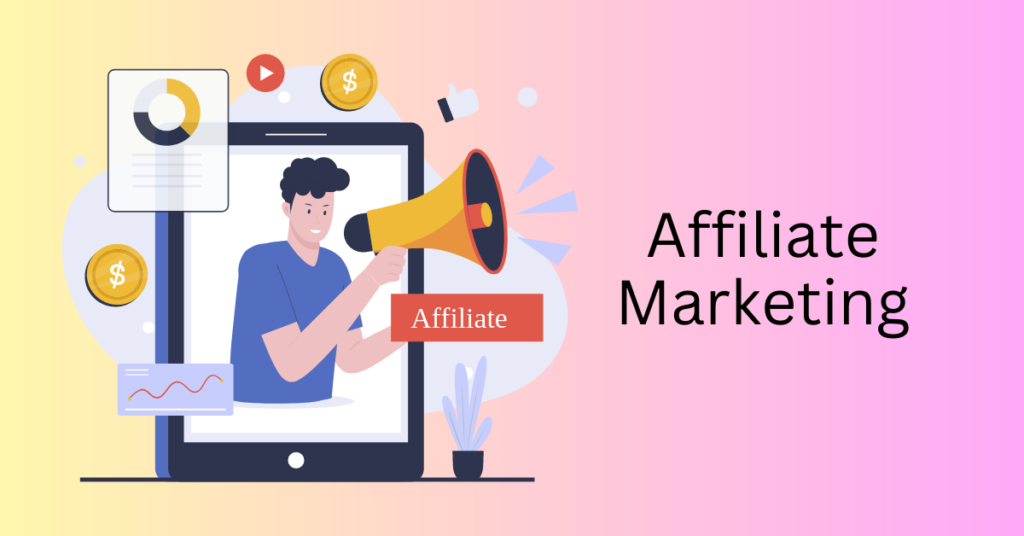
Affiliate marketing is also collaborations with others to promote your products. However, affiliate marketing is performance-based marketing. You are not going to pay the affiliate marketers in advance. Instead, they are paid based on successful sales.
An affiliate marketer will first sign up for your affiliate program. And then, they will be the ones working hard to get people to your sales page and buy from you. After the sales are confirmed, they will then be credited for the sales and get a commission for it.
With affiliate marketing, you only spend for the commissions of successful sales. You might need to pay a good commission for this to lure affiliate marketers to promote your products.
However, it is very powerful if you can get the right marketers to promote your products.
6. Email Marketing – Digital Marketing
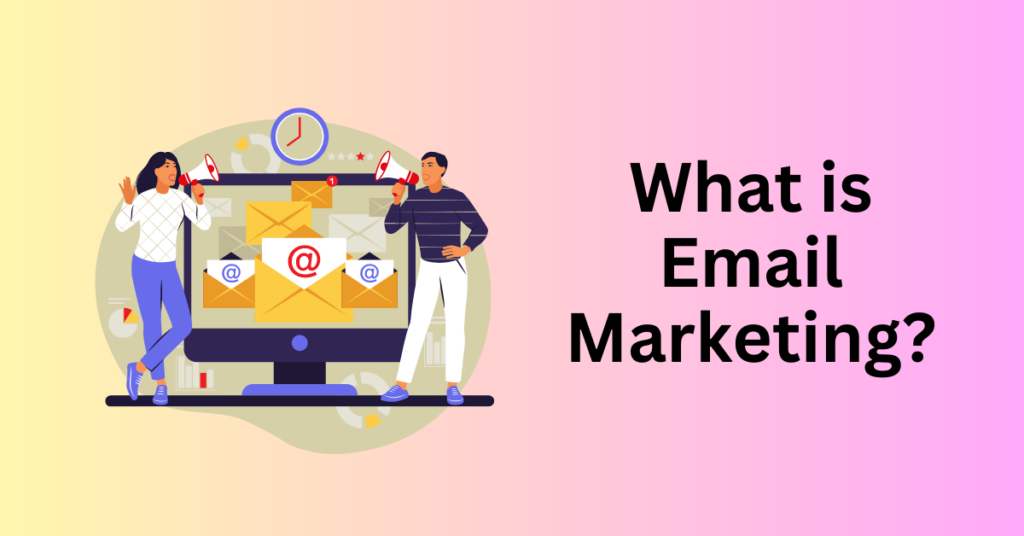
Email marketing is one of the low-cost, high-ROI marketing methods. You need to work on lead generation to build your email lists in the beginning. As your list grows, you just need to set up the right email automation campaign for it to run.
You can set up your squeeze page for lead generation. Then, integrate your squeeze page with your autoresponder to send emails out automatically when someone joins your list.
With email marketing, you can segmentize your list to build brand awareness, promote your products or services, drive web traffic and create and nurture leads. Depending on your subscribers’ reactions and behaviour, you can segment them to receive different emails. This is to ensure the emails can resonate with them better based on their interests.
Here are some emails that you will be sending for your email marketing campaign:
Welcome Email Sequence
This email sequence will be sent out to welcome your new subscribers. You can introduce your new subscribers to what they can expect from your list. Normally, you can create a five-day email sequence. This is where you can build initial relationships with them before sharing your first offer at the end of it.
Newsletter Emails
This is a regular email that you send out to nurture your list by providing value to them. You may not need to sell any offers directly with the newsletter emails. But instead, share their value and get them to trust you. You may embed your links in the emails so they can click and visit your sales page.
Promotional Emails
When you have any new product releases, collections or discounts, you can send them the info through emails so they can get early or exclusive access before the rest.
Abandoned Cart Emails
For eCommerce, this is important. You can send them reminders to complete the purchase for things they added to the cart but did not complete the purchase. By doing this, you can recover many lost sales by sending out abandoned emails to get them to complete the order. You can include the items in the cart in your emails too.
Follow-up Emails
This is very useful to show your gratitude for the sales and what they can expect from the purchase. Not only that, but you can also share the shipping info or how to access the product if it’s a digital product.
In your follow-up emails, you can get them to buy more with a better offer or even follow up with those who are still yet to make up their mind to buy.
7. Content Marketing – Digital Marketing
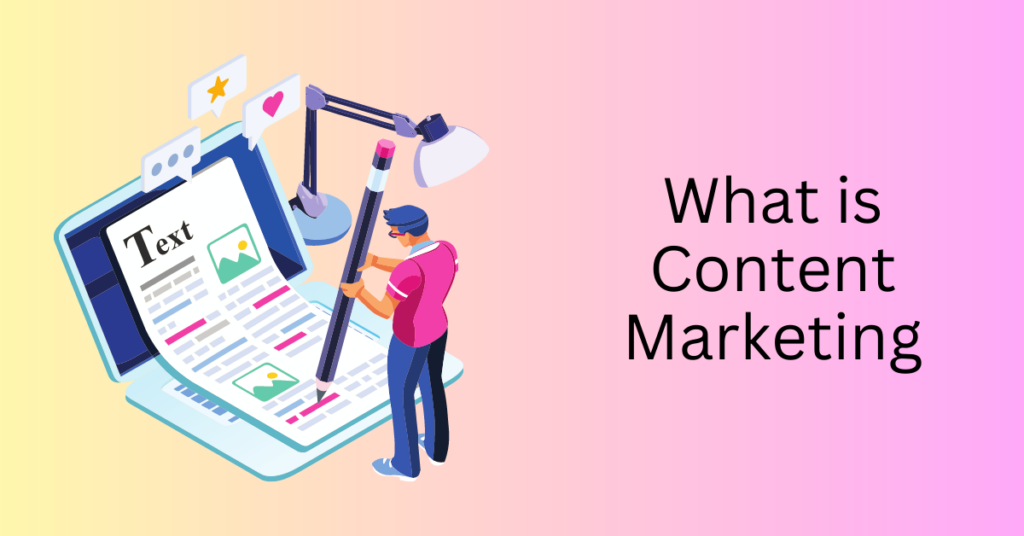
Content marketing is a strategic marketing approach that involves creating and distributing valuable, relevant, and consistent content to attract and engage a target audience. The primary goal of content marketing is to build and maintain a loyal customer base. This is done by providing valuable information and solutions to their needs and interests.
This approach differs from traditional advertising, as it focuses on delivering content that educates, entertains, or informs rather than directly promoting a product or service.
Content marketing helps to build organic relationships with your audience and potential customers by providing value to them. And at the same time, your content is identified as the authority in your niche. This will help to grow trust for your customers.
Differing from other paid or traditional marketing, all content is created to create brand awareness and get sales for your business. In your content, you focus on providing value to your customers to build a reputation. For the sales part, you can embed your landing page link in your content and direct your audiences to your landing page to get sales. All the sales processes will start on the landing page.
8. Native Ads – Digital Marketing
Native advertising is a strategic approach within digital marketing that seamlessly integrates promotional content into the user experience of a particular platform.
Unlike traditional ads that are easily distinguishable from the surrounding content, native ads are designed to blend harmoniously with the form and function of the platform they appear on. This form of advertising aims to provide value to the audience by delivering relevant and engaging content that feels natural, thereby enhancing user engagement and reducing the disruptive nature associated with conventional ads.
Native ads can take various formats, including articles, videos, social media posts, and even sponsored content within mobile apps. The success of native advertising hinges on its ability to strike a balance between delivering marketing messages and aligning with the user’s expectations and interests.
To implement native ads, first, understanding the platform and its audience is paramount. Each platform has its unique style and user behaviour. By tailoring native ads, you can match these essential characteristics.
Next, creating high-quality and valuable content is crucial. The content of native ads should be informative, entertaining, or educational, providing the audience with something valuable beyond the sales pitch. This can involve storytelling, relevant visuals, and a tone that resonates with the platform’s users.
Additionally, transparency is key. While the goal is to blend in, it’s important to indicate that the content is sponsored or promoted. This builds trust with the audience and ensures ethical marketing practices.
Finally, continuous monitoring and optimization are essential. Analyzing engagement metrics and user feedback helps refine native ad strategies over time, ensuring they remain effective and aligned with audience preferences.
In essence, native advertising represents a harmonious convergence of advertising and content, creating a win-win situation for both marketers and consumers.
Why Digital Marketing For Your Business
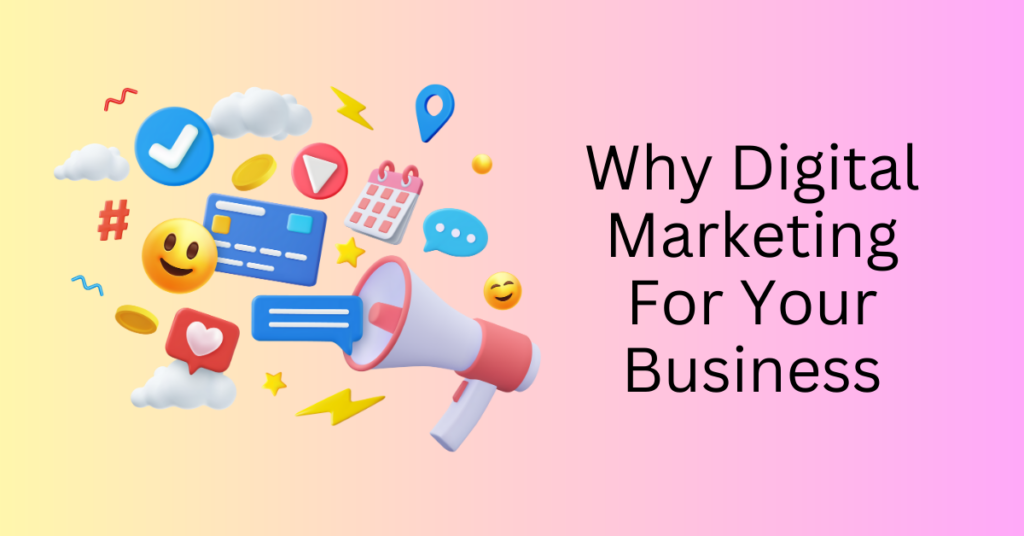
There are a lot of benefits to implementing digital marketing for your business. You can reach a larger group of audiences more easily at a lower cost.
Here are some benefits that you can enjoy from implementing digital marketing.
Lower Cost
Digital marketing is more affordable to implement compared to traditional marketing. For example, you may need a few hundred thousand to put up a billboard ad or TV ad. And you have no visibility on who is viewing your ads making it hard to follow up with them.
Digital marketing, on the other hand, allows you to start advertising with just $1 a day as a minimum. But of course, we do recommend starting with $5 per ad per day so that you can get enough data to decide for your next step.
Besides, you can create targeted ads for your target customer group. Also, with the data collected from the marketing campaign and the lead’s information collected, you can follow up with your potential customers easily through emails or social media.
Global Reach
With the power of the internet, you can access anyone online. Digital marketing has taken away the barrier of location and connecting you to your potential customers across the globe.
When you are limited to a physical location, you might miss so many opportunities to grow your brand and business worldwide. This is especially important if you are selling digital products or services where you can deliver them virtually to your customers through the Internet.
You can then sell your products to a larger group of customers and boost your revenue.
Measurable results
Data analysis is vital to know how your marketing campaign performs. With digital marketing, you can set up tracking tools to measure the effectiveness of your campaigns, conversion rate and ROI.
For example, if you are running a paid ad campaign on social media, you can know what is the return of ad spend (ROAS) for each ad variant and focus on scaling those who are performing.
Not only that, you can know exactly how many customers are going through which step in your sales funnel. Then, you can retarget them with different ad copy or follow-up emails that resonate with their concerns better.
Flexibility
With digital marketing, you can adapt and optimize your marketing campaign quickly based on the market trends and the latest changes.
When you see some changes in trend, you can create another ad set to target the changes instantly without even requiring to engage with your designer. Instead, you can directly log into your ad platform and create new ads to publish almost instantly.
This will enable you to be fast to reach the market and your target customers before your competitors do.
Challenges of Digital Marketing
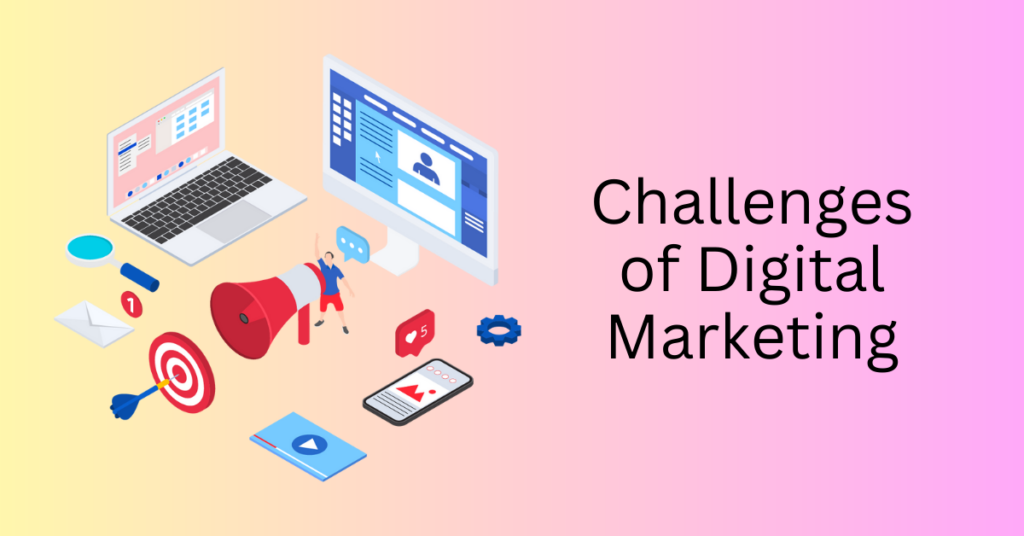
After looking at the possible ways to implement digital marketing and the benefits of it, it’s time to talk about the real challenges of implementing it.
Skill Requirements
You will need to train your skills to be good at digital marketing. Also, digital marketing strategies are always evolving. You need to be able to adapt to the latest trends and make changes to your marketing strategy fast to adapt to it.
For example, if you are going for the organic way of SEO marketing, you will need to always be aware of the latest algorithm changes and how your competitors are doing. People are always fighting to rank at the top on the same keywords. You can’t just implement your SEO strategy and hope that it will stay there forever. There will be people that try to outrank you and you will need to further optimize your content to stay on top.
And for paid ads, the direct impact would be your ad budget. If you don’t know what you are doing, you will most probably run out of budget too fast without making enough revenue to cover the ad cost.
Hence, you need to always keep learning and adapt to the latest technology and trends to stay ahead.
High Competition
Digital marketing is how marketing has gone these few years and more businesses will go online. There is so much competition out there.
Instead of competing with local businesses only, you are now competing at the global level. There are people from different backgrounds and expertise who are working in the same niche. You need to show your unique selling point to get people to buy from you.
Legal and Privacy Issues
When you are running global, there are different laws that you need to comply with. For example, when you are collecting customer data for your marketing campaigns, you will need to comply with privacy laws, such as the European Union’s General Data Protection Regulation (GDPR) and the California Consumer Privacy Act (CCPA).
For your landing page or website, you will need to have the T&C and other policies in place to protect you from any legal issues.
This is not a legal advice. You should always get your lawyer for advice on this.
Final thoughts: What Is Digital Marketing, and Why Is It Important For Your Business?
Digital marketing is how small businesses can start implementing marketing for their company with a relatively low budget. With an effective digital marketing strategy, you can reach audiences worldwide in no time.
By leveraging the power of digital marketing, you can use social media, email, search engines and ads to reach global audiences and convert them to your customers.
